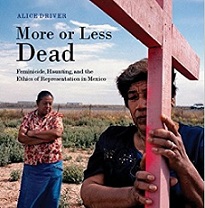
More or Less Dead, author Alice Driver’s first book, is a critical and timely look at the ethics of portraying violence against women in the media. The book’s title refers to the ways that disappearances leave families in limbo, robbing the victim of even having the right to death. Although Driver focuses on the issue in the context of Mexico, the ideas and conclusions she comes to are equally applicable to other cultures and geographies.
![]() More or Less Dead: Feminicide, Haunting, and the Ethics of Representation in Mexico (University of Arizona Press, 2015).
More or Less Dead: Feminicide, Haunting, and the Ethics of Representation in Mexico (University of Arizona Press, 2015).
More or Less Dead, author Alice Driver’s first book, is a critical and timely look at the ethics of portraying violence against women in the media. The book’s title is taken from a novel by Chilean writer Roberto Bolaño. It refers to the ways that disappearances leave families in limbo, robbing the victim of even having the right to death. Although Driver focuses on the issue in the context of Mexico, the ideas and conclusions she comes to are equally applicable to other cultures and geographies.
Driver distinguishes between the word “femicide”, the murder of women and girls, and “feminicide”, the murder of a person because she is a woman. In many conflict-riddled societies, men are killed in larger numbers than women. However, the issue of women being killed, often directly because of their gender, is an area that is often neglected or conflated with other forms of violence. Driver eloquently argues for the need to study violence against women as its own phenomenon, while also recognizing that it is not unrelated to violence against men.
Perhaps the best-known example of widespread violence against women in Mexico is the case of Ciudad Juárez. Driver says of Juárez that “free-trade is producing poor people and dead people faster than any other product”. Reliable statistics on murder rates in Juárez are non-existent, but one estimate suggests that femicides make up less than one-in-five of all homicides. Many more women have also been disappeared over the past twenty years in this northern border city.
All too often, media reports of feminicide are accompanied by photographs of naked dead women, a practice Driver describes as sexist and unethical. Gruesome pictures of brutalized bodies are commonplace in Mexico and make for grim headlines around the world. These images can be traumatic for both the victims’ families and the audiences for whom they are intended, which begs the question: what purpose do they serve?
Driver argues that while NGOs, film-makers and the media focus on these sexualized-torture murders, the brutality of domestic and economic violence against women remains relatively invisible. Driver largely condemns more sensationalistic forms of media, which she sees as dehumanizing and a second victimization. She is critical of portraying female victims as “singularly sexual beings”, who are often posthumously described not the way they were in life, but with a focus on the shade of lipstick they were wearing when they were killed.
In More or Less Dead, Driver maintains that we must move beyond images of crying mothers and sexualized dead bodies in order to address the gender inequalities and structural causes that contribute to feminicides. Instead of blaming women for what they wear, we should instead question the responsibility of the media, employers and the state to ensure women’s safety.
This book posits practical techniques that could revolutionize media portrayal of feminicide if taken into account. Unfortunately, the academic writing style will make this book less accessible for many who would benefit from its wisdom. It would be great to see a version of this book more suitable for a generalist audience, as some of the ideas are key to understanding current problems with media portrayals of violence against women.
In an ideal world, the ideas in this book would be compulsory learning for anyone in the media or working on issues of violence against women. Driver grapples with the complexities of representing victims of violence in ways that are respectful while also exposing the greater causes of systemic violence. Headline-grabbing journalism may get 30 seconds of attention on an issue, but this shock-value can come at a high cost to victims and their families. At the end of the book, we are left with a key question: At what point are descriptions of violence instructive, and when do they cross the line and become part of the problem?
Jen Wilton is a freelance journalist, researcher and photographer currently living in London, UK. In 2013 Jen spent time in Mexico working on an Investigative Journalism Fellowship for the Tyee, Canada, looking at Canadian mining in the region. She reports on social and political issues related to Mexico and Latin America more widely. Her particular interests include indigenous rights, migration and the role of the extractive industries. Jen has also been published by the Guardian UK, Canadian Dimension, ROAR mag, Latino Rebels and the Dominion (Media Co-op Canada).
